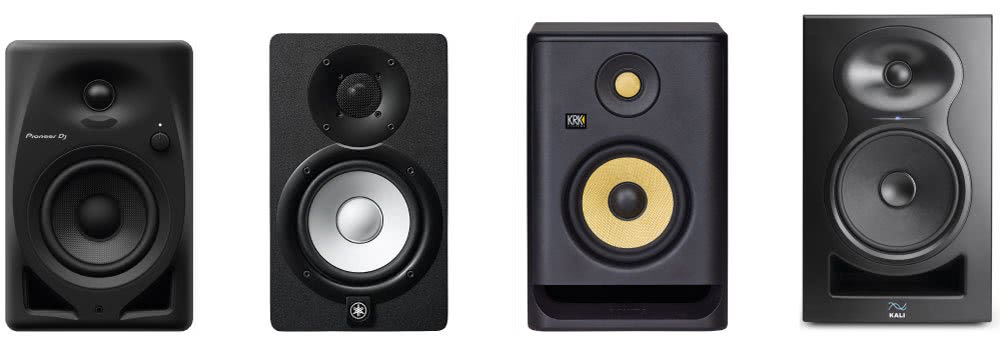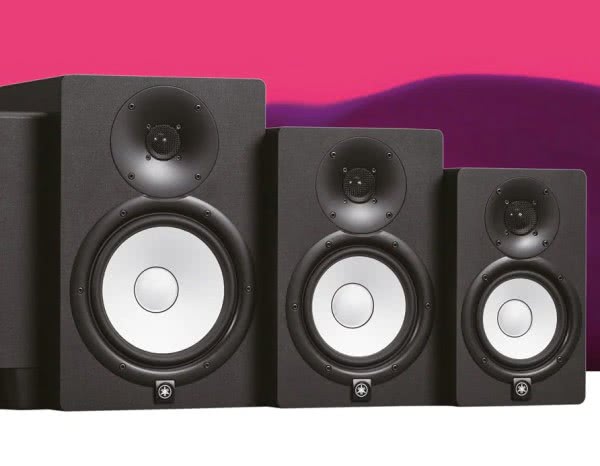While the number of bedroom DJs and home studios is rising, small active speakers are becoming the most convenient option for monitoring purposes. One common question is whether the so-called “Studio Monitors” serve just as well for DJ-ing purposes, as for music production.
The short answer is: Yes they do.
They are fantastic for DJ-ing at home or in a small studio, as they are highly convenient. Most of them are active speakers which means that they have their own built-in amplifiers, so all you will need is signal cables (usually XLR / RCA / JACK) from your DJ mixer or DJ controller.

But what about the sound? Are the flat response studio monitors suitable for DJ-ing?
“Flat” is a buzzword when it comes to studio monitors. A flat response means that the sound is not cut or boosted across the frequency map, and it is exactly like the original source. For example, if a speaker sounds a few decibels louder in the 70 to 120 Hz frequency range, it has a boost on the bass. While cutting and boosting certain frequency ranges can make the mix sound better, music producers will be looking for speakers that reproduce sound more accurately. Most professionals agree that if you can get your mix right without any EQ, it will sound good on any speaker.
So is flat response necessary for DJ-s?
It is definitely a good thing for monitoring, as it can bring your EQ-ing skills to another level. If you can smoothly blend 2 (ore more) songs on flat response speakers, they will most likely sound great on a large soundsystem as well. Some manufacturers, like Yamaha are famous for their exceptionally flat sounding speakers, but this doesn’t mean you will get all the benefits in your home studio. In fact, to achieve a true flat response you will first need to get your speaker positioning and acoustic treatment right.
The first rule would be to keep your speakers at least 20-30 cm away from walls and corners in order to prevent sound waves to bounce back, resulting in phase cancellation or other acoustic interactions. Ideally, the distance between the two speakers, and the distance between you and the speakers should be the same. You can think about it as a triangle with equal sides. You should also pay attention to keep the speakers at an equal distance from the walls on the left and the right.
Keep in mind that the tweeters should be aligned in height to your ears, as higher frequencies are much more directional than mid and low range. You can easily adjust this with various speaker stands, like the Soundsation TSMON-150 for desks, or the SMON-200 floor stand.
These are just the very basics of getting the sound right. Most studios will also need adequate acoustic treatment with foam panels in order to prevent the sound waves from bouncing back. Manufacturers are aware that in most cases, setting up properly is just not possible, so any respected brand, like the Yamaha HS Series, KRK Rokit, Kali Audio or Gibson offer at least the option to cut a few decibels on the low and the high frequencies in order to compensate for poor positioning. By cutting back on the bass, your mix will sound less muddy, and you will here more clearly what you are doing while blending two tracks together. However, it can not compensate entirely on poor positioning, so if you are not lucky enough to be able to place your speakers properly you just have to accept that you cannot achieve that perfect flat sound, no matter how expensive speakers you buy.
So before you start hunting for the flattest sounding monitor, make sure if it is even possible for you to get the positioning right in your room. If your space is just not optimal for an adequate setup, then you shouldn’t stress too much on speaker specifications, just make sure you get the ideal sized monitors for your room.
Remember: the bigger is not always the better in this case!
If you buy an oversized monitor it will most likely enable all the resonances that exist in your room, and it will result in a horrible acoustic experience. Generally you should be aiming for 5” or at most 6” monitors for any room smaller than 15 m2. For some casual fun, you can even get away with a pair of 4” Pioneer DJ DM 40 speakers or the more enhanced DM-40D. The 3” Hercules DJ Monitor 32 can be perfectly fine as well if you cannot afford to go too loud anyway.
For anything larger than 15 m2, you can go for 7” or 8”. If you still want to enjoy your basslines to the fullest in a smaller room, we recommend that you buy a pair 5” speakers with a subwoofer, as a sub can reproduce the basslines more effortlessly without going too loud on the overall spectrum. For example a Yamaha HS8 can go as low as 38 Hz, while the Yamaha HS8S subwoofer can go all the way down to 22 Hz with less effort, resulting in much more natural sounding basslines, and it frees up some headroom for your small speakers so they will handle better everything from the kicks up to the hi-hats. If you will be using your monitors for DJ-ing, you should really consider adding a subwoofer to your setup to get the most out of the basslines of your tracks, of course as long as you have enough space for it.
So why studio monitors for DJ-ing purposes and not Hi-Fi speakers?
First of all, studio monitors are usually active speakers, this means that you don’t have to cram in an individual power amplifier to your DJ booth, you can connect directly from your mixer or your controller. They are a very convenient way to start DJ-ing at home or in a small studio.
Secondly, most entry level studio monitors are nearfield monitors, which means that they are designed for listening from close distances. When you DJ at home, you will probably want to listen to your mix as loud as possible, without annoying your neighbours, or anyone else in your home, and by placing your speakers as close to you as possible, you don’t have to go too loud. This also makes them the best option for an environment with poor acoustics, as nearfield monitors enable less resonance in your room.
If you can also get your positioning right, and maybe add some acoustic panels to your room, you may even benefit from their flat response and bring your mixing skills to the next level.
In any case, they are great choices for your DJ setup, and most likely they will have less impact on your mixing skills than the hours of practice you put into DJ-ing, so just try the get the basics right, like size, positioning, and maybe some acoustic treatment if possible, and you will have a lot of fun while DJ-ing at home!

